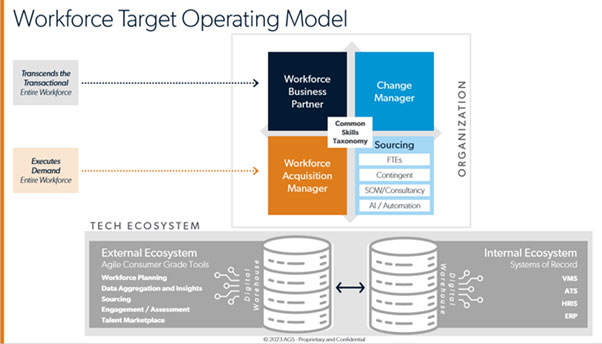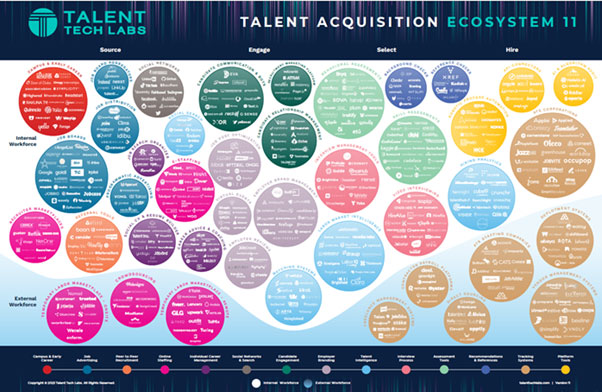The wheel was invented at least 5,500 years ago, while the word “luggage,” meaning “inconveniently heavy baggage,” first came into use in the late 16th century. But it wasn’t until 1970 that an American inventor put the two together, attaching wheels directly to a suitcase.
What’s our point? We humans are pretty smart, but we have the capability to miss the blindingly obvious because too often we continue to do things the way they’ve always been done.
Now, in 2023, the workforce industry is at its “wheels on suitcases” moment — one in which a new organizational target operating model is helping enterprises redesign work with an eye to becoming skills-based organizations. The result: impressive gains in workforce productivity.
Yet, we continue to witness organizational angst when it comes to managing talent and driving business success, no matter what type of resources are involved. In our experience, many organizations make three fundamental errors when engaging the workforce:
- Ineffective job descriptions and resumes: In today’s typical hiring process, companies define who they want to hire in job descriptions and specifications, then attempt to match them against peoples’ experiences via resumes. But what if we flipped the narrative and instead matched skills to tasks? That way, companies can focus on what they want to achieve and then source the necessary skills and behaviors via individuals who will complete the desired tasks.
- Siloed workforce channels: Most organizations have a siloed approach to hiring, where full-time employees (FTEs), contractors, freelancers, consultancies, and statements of work (SOWs) are all sourced through separate teams with separate systems, approvals, and processes. When choosing the channel is the first stage of the process, a less-than-optimal channel may be selected. The result? The opportunity to consider more than one option or a hybrid solution is lost, and business productivity and profitability are drastically reduced.
- Technological chaos: Organizations already have core systems of record, such as finance, procurement, HR, recruitment applicant tracking software (ATS), and vendor management systems (VMS). But they also want to leverage agile technology that supercharges the efficacy of these core systems. Examples of such technologies include digital candidate engagement, talent marketplaces, artificial intelligence (AI)-driven sourcing, market intelligence, and video screening.
For many organizations, using multiple bolt-on tools means settling for a workforce tech ecosystem that leaves their hiring teams deeply disappointed because systems are bought but never fully deployed, don’t integrate or automate in the promised ways, or are mismanaged due to their complexities. Budgets, schedule, quality, and applicant and hiring manager experience all suffer.
In our book The Universal Workforce Model, we proposed an outcome-based approach to harmonized workforce management with three core elements that form the foundation for future success. These include:
- A task/skills-based approach to getting work done.
- A harmonized approach to the workforce.
- A platform approach to simplify workforce technology.
As a natural evolution from the Universal Workforce Model — and as a way to further accelerate enterprise growth and operational productivity, reduce costs, and improve the entire experience — we have created the Workforce Target Operating Model (TOM) below.
Workforce Target Operating Model (TOM)]

We believe this new model enables businesses to save millions of dollars on current operating expenditures and transform productivity by getting work done in the most efficient and effective ways.
As previously noted, the traditional siloed approach to workforce management reduces options and drives inefficiency. The best example is the tens or hundreds of millions of dollars that large organizations typically spend on consultants or SOWs when our managed services experience of working with the world’s largest organizations over the last few decades tells us that 25% to 60% of this spend could be delivered more efficiently.
The Workforce Model for the Future
The new Workforce TOM drives transformation through a four-part organizational model supported by a realistic and simplified workforce technology ecosystem:
- The Workforce Business Partner. We previously introduced the role of a workforce business partner (WBP) in the Universal Workforce Model framework, with a nod to the successful HR business partner model originally conceived by Dave Ulrich and now adopted almost universally by major organizations. The WBP advises the organization’s leadership through a role that transcends the transactional. This approach incorporates advice for business leaders on the most appropriate workforce options, spanning internal staffers, external FTE hires, contractor hires, consultancies, and SOW options.
The WBP is a senior and experienced individual, able to deconstruct roles into tasks and, where appropriate, look for automation opportunities, such as using AI. The WBP also advises on the most effective balance of resources to deliver the outcome the business needs, without predetermining the categorization of the workforce that is needed.
The WBP will advise on questions such as:
- How have we done this before?
- Could part of this role be automated using AI or other tools?
- Could we hire a blend of FTE, contract, and consultancy services?
- How can I work out the optimal location strategy?
- What are the relative pros and cons — such as cost, risk, and speed — for deployment of my various options?
Where we have seen this role deployed, the WBP uses workforce/resource planning tools as a real-time dashboard for managing requirements proactively, optimizing the use of internal skills first before moving to consider external resources. The WBP uses technology, such as the Intelligent Workforce Platform described below, to provide analytics fueled by an aggregated view of internal and external data.
- The Workforce Acquisition Manager. The WBP is supported by an execution role known as a workforce acquisition manager (WAM). The WAM owns the execution for all hiring for their business area across all channels to market. As a result, hiring managers and business leaders no longer need to decide whether they need an FTE, temporary, or consultant resource as a first step; their access point for resources is the same.
In cases where business leaders know exactly what they need (for example, “Jenny has left, and I just need to replace Jenny; please don’t overcomplicate this!”), the WAM is contacted directly, while the WBP isn’t engaged in the process.
- The Change Manager. The new Workforce TOM includes a change function to ensure successful deployment and future-proofing of the model. As new technologies become available, the change manager oversees their incorporation and successful deployment into the Workforce TOM and the technology ecosystem.
- The business-facing element of the Workforce TOM is completely different from how most enterprises currently understand and approach workforce demand. However, companies still need to source people to do the work once they have identified the most appropriate resource blend. This could be managed in-house, outsourced, or a hybrid approach. The structure of the sourcing execution doesn’t need to differ from successful models currently deployed, but the Intelligent Workforce Platform makes it much easier to link resource planning directly to sourcing and implement state-of-the-art sourcing tools, including the generative AI tools of tomorrow.
Technology Ecosystem: The Intelligent Workforce Platform
A crucial element of the new Workforce TOM is the ability to deploy technology in ways that give business leaders the data-driven vision needed to make informed workforce decisions and drive tangible business impact. As described earlier, organizations typically have systems of record such as finance, human resources information system (HRIS), ATS, and VMS, but they struggle to effectively implement agile workforce technology such as candidate engagement, AI sourcing, and video screening. The result is chaotic and impossible to implement, as shown by the (simplified!) diagram below.
Talent Acquisition Ecosystem
Source: Talent Tech Labs. Used with permission
https://talenttechlabs.com/talent-technology-interactive-ecosystem/

There is a much simpler answer, but we are missing the obvious: using two complementary ecosystems with a single integration between them. Core internal systems such as HR and finance remain the systems of record. An external data warehouse acts as the platform to access the agile tools that deliver the consumer-grade experience that managers and applicants crave. This external ecosystem is called an intelligent workforce platform.
How does this Workforce TOM address the flaws in the current model?
- It focuses on the tasks and skills required rather than on ineffective job descriptions and resumes. In this new model, the starting point isn’t a job specification but instead an understanding of what the organization is trying to achieve. Business leaders have a WBP to help capture the necessary skills and behaviors and consider internal resource optimization as a first step.
- It harmonizes siloed workforce channels. The structure of the Workforce TOM spans all resourcing options. Both the WBP and the WAM span internal, FTE, contingent, and consultancy/SOW hiring.
- It simplifies the workforce technology ecosystem to clear the chaos. The intelligent workforce platform makes the implementation of today’s desired workforce ecosystem possible and future-proofs the model for the technologies of tomorrow. The result is a transformed experience for managers and applicants that turns data and technology into business advantage.
We don’t underestimate the amount of change required for organizations to move to the new Workforce TOM, but now is the time to take the first steps. The constituent parts are all there. If the workforce is critical to your organization’s productivity, it’s time to start your workforce transformation. It’s time to put the proverbial wheels on the suitcase.
[Bio] About the Authors
Simon Bradberry, vice president for the EMEA region at Allegis Global Solutions, is a workforce transformation professional with more than 25 years of experience in workforce strategy and execution. Bruce Morton, global head of strategy at Allegis Global Solutions, has more than 40 years of experience in the human capital industry and is well known as a global workforce design and talent acquisition expert. They are the coauthors of The Universal Workforce Model: An Outcome-First Guide to Getting Work Done.
[Boilerplate] About Allegis Global Solutions
At Allegis Global Solutions, we’re in the human enterprise business, designing workforces to meet missions. We help companies all over the world transform their people into a competitive advantage. We believe that when you build a workforce designed to harness human enterprise, you design a workforce built for impact. Learn more at AllegisGlobalSolutions.com.


